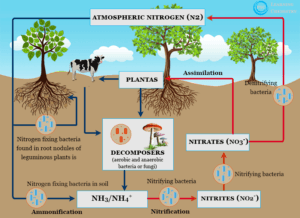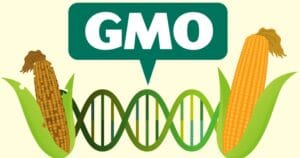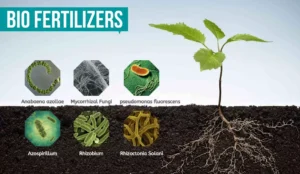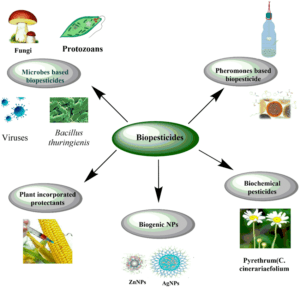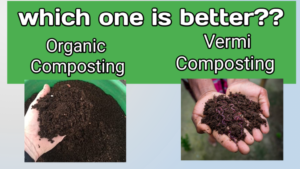Agrobacterium-mediated gene transfer, also known as transformation, is a widely used method for introducing foreign genes into plants. This technique takes advantage of the natural ability of Agrobacterium tumefaciens, a soil bacterium, to transfer its own DNA (T-DNA) into plant cells. The process has been harnessed for biotechnology purposes to create genetically modified (GM) plants with desired traits.
Here is an overview of the Agrobacterium-mediated gene transfer process:
- Selection of Agrobacterium Strain:
- The commonly used strain is Agrobacterium tumefaciens, which naturally causes crown gall disease in plants.
- Researchers often use a modified strain with a disarmed Ti (tumor-inducing) plasmid, where the disease-causing genes are removed but the T-DNA region is retained.
- Plasmid Construction:
- The gene of interest, or the transgene, is inserted into the T-DNA region of the Ti plasmid.
- Selectable marker genes (e.g., antibiotic or herbicide resistance genes) are usually included to aid in the identification and selection of transformed cells.
- Culturing Agrobacterium:
- Agrobacterium cells containing the engineered Ti plasmid are cultured in a suitable medium.
- Infection of Plant Cells:
- Plant tissues (usually young explants or callus cultures) are exposed to the Agrobacterium culture.
- Virulence proteins produced by Agrobacterium facilitate the transfer of T-DNA into the plant cells.
- Integration of T-DNA into Plant Genome:
- The T-DNA containing the transgene integrates into the plant genome. This integration is a random event, and the number of integrated copies can vary.
- Selection of Transformed Cells:
- Selectable marker genes aid in the identification of transformed cells. For example, if an antibiotic resistance gene is used as a marker, only cells that have taken up the transgene and the marker will survive in the presence of the antibiotic.
- Regeneration of Transgenic Plants:
- Transformed cells are cultured and regenerated into whole plants through tissue culture methods.
- Characterization and Testing:
- The resulting transgenic plants are characterized, and the expression of the introduced gene is verified.
- Molecular techniques such as PCR, Southern blotting, and gene expression analysis are commonly used for confirmation.
Agrobacterium-mediated gene transfer has been successful in a wide range of plant species, making it a versatile tool for genetic engineering in agriculture. This technique has been used to introduce various traits into plants, including resistance to pests and diseases, improved nutritional content, and tolerance to environmental stress. It is crucial to note that the use of genetically modified organisms is subject to regulatory approvals in many countries to ensure safety and environmental considerations.
Overview Agrobacterium-Mediated Gene Transfer
Agrobacterium tumefaciens in plant genetic engineering has indeed made it a powerful tool in agriculture and biotechnology.
- Pathogenicity and Crown Gall Disease:
- Agrobacterium tumefaciens is a phytopathogen causing crown gall disease in plants.
- It infects plants through wound sites, introducing its T-DNA into the host cells.
- Genetic Diversity and Host Range:
- The genus Agrobacterium includes different species such as A. radiobacter, A. vitis, A. rhizogenes, A. rubi, and A. tumefaciens.
- The host range of Agrobacterium is influenced by both bacterial and plant factors, including virulence genes, T-DNA oncogenes, and genes required for transformation and tumor formation.
- Plasmids and Transformation:
- The Ti/Ri plasmid is a primary pathogenic determinant in Agrobacterium.
- Different strains of Agrobacterium, isolated from various host plants worldwide, carry plasmids that contribute to their ability to transfer DNA into the genome of host cells.
- Bacterial Characteristics:
- Agrobacterium tumefaciens is a Gram-negative, rod-shaped bacterium with motility facilitated by flagella.
- It does not form spores and is strictly aerobic, residing in the soil.
- Applications:
- Agrobacterium has clinical and biotechnological applications, with a significant focus on its use as a plant transformation tool in agriculture.
Understanding the biology and characteristics of Agrobacterium is essential for harnessing its potential in genetic engineering for crop improvement and other agricultural applications. The bacterium’s natural ability to transfer genetic material into plants has revolutionized the field of plant biotechnology and contributed to the development of genetically modified crops with enhanced traits.
Factors affecting Agrobacterium-mediated Gene Transfer
Several factors can influence the efficiency and success of Agrobacterium-mediated gene transfer in plants. These factors encompass both bacterial and plant-related parameters. Understanding and optimizing these factors are crucial for achieving successful transformation. Here are some key factors:
- Agrobacterium Strain:
- The choice of Agrobacterium strain is important. Strains with a high transformation efficiency and reduced virulence (disarmed strains) are commonly used.
- Plasmid Design:
- The design of the binary vector carrying the transgene and selectable markers influences transformation efficiency.
- Proper orientation and arrangement of T-DNA elements, such as promoters and terminators, impact gene expression.
- Selection of Promoters:
- The choice of promoters for driving the expression of the transgene can affect its level of expression.
- Strong and tissue-specific promoters may enhance the desired trait expression.
- Selection Markers:
- The use of effective selectable markers (e.g., antibiotic or herbicide resistance genes) helps identify transformed cells.
- Choosing markers suitable for the specific plant species is essential.
- Cultivation Conditions:
- Agrobacterium cultures should be grown under optimal conditions, including appropriate media, temperature, and shaking speed.
- Maintaining the right pH and oxygen levels is crucial for Agrobacterium viability.
- Bacterial Density:
- The concentration of Agrobacterium cells used for plant infection can influence the transformation efficiency.
- An optimal bacterial density should be determined for each specific plant system.
- Co-Cultivation Period:
- The duration of the co-cultivation period, during which Agrobacterium and plant cells are in contact, is critical.
- It allows for the transfer and integration of T-DNA into the plant genome.
- Plant Material:
- The type of plant material used for transformation (e.g., explants, callus, or embryogenic tissues) affects the success of transformation.
- The age and physiological state of the plant material can also impact transformation efficiency.
- Infection Methods:
- The method of introducing Agrobacterium into plant cells (e.g., vacuum infiltration, agroinfiltration, or leaf disc transformation) can influence transformation efficiency.
- Genetic Factors:
- The genetic makeup of both the Agrobacterium strain and the plant species influences the success of gene transfer.
- Compatibility between the bacterial and plant factors is crucial for efficient T-DNA transfer.
- Wound Response:
- Wounding of plant tissues at the site of infection enhances the Agrobacterium-mediated gene transfer process.
- Wound-inducing methods or treatments may be employed to facilitate the transformation.
- Post-Transformation Care:
- Proper care and selection of transformed cells during the regeneration phase are essential.
- Providing suitable growth conditions for the recovery and development of transgenic plants is critical.
By carefully optimizing these factors based on the specific requirements of the plant species and the desired trait, researchers can enhance the efficiency of Agrobacterium-mediated gene transfer for successful plant transformation.
Principle of Agrobacterium-mediated Gene Transfer
The principle of Agrobacterium-mediated gene transfer involves exploiting the natural ability of the soil bacterium Agrobacterium tumefaciens to transfer a specific segment of its DNA (known as the transferred or T-DNA) into the genome of plant cells. This process is primarily used in genetic engineering to introduce foreign genes into plants, resulting in the development of transgenic plants with desired traits. Here is an overview of the key principles:
- T-DNA and Ti Plasmid:
- Agrobacterium tumefaciens harbors a tumor-inducing (Ti) plasmid, which contains a specific region called the transferred DNA (T-DNA).
- The T-DNA is responsible for causing crown gall disease in susceptible plants.
- Virulence Factors and Recognition:
- When Agrobacterium encounters a wounded plant cell, it recognizes specific plant signals, such as phenolic compounds released from the wounded site.
- Virulence factors, encoded by various genes on the Ti plasmid, facilitate the recognition and response to these plant signals.
- Attachment and Entry:
- Agrobacterium attaches to the wounded plant cell and induces the formation of a structure called the T-pilus.
- The T-pilus facilitates the transfer of the T-DNA and other effector proteins into the plant cell.
- Type IV Secretion System:
- Agrobacterium utilizes a type IV secretion system (T4SS) to transfer the T-DNA across the bacterial and plant cell membranes.
- This complex secretion system allows the direct transfer of T-DNA from the bacterium into the nucleus of the host plant cell.
- Integration into Plant Genome:
- Once inside the plant cell, the T-DNA is transported to the nucleus, where it integrates into the host plant genome.
- The integration is a random event, and the foreign genes carried by the T-DNA become part of the plant’s genetic material.
- Formation of Crown Gall and Tumor:
- In nature, the transferred genes often include oncogenes that induce uncontrolled cell division, leading to the formation of a characteristic tumor or gall on the plant.
- In genetic engineering, the oncogenes are usually removed or modified to avoid undesirable effects, and the T-DNA is used to introduce beneficial traits.
- Selectable Marker Genes:
- The T-DNA often carries selectable marker genes, such as antibiotic or herbicide resistance genes, to aid in the identification and selection of transformed plant cells.
- Regeneration of Transgenic Plants:
- Transformed plant cells are cultured and regenerated into whole plants using tissue culture techniques.
- The resulting transgenic plants carry the introduced genes in their genome and express the desired traits.
By harnessing the natural mechanism of Agrobacterium-mediated gene transfer, researchers can introduce specific genes into plants with relative ease and efficiency. This method has been widely adopted in plant biotechnology for the development of genetically modified crops with improved characteristics, such as resistance to pests, diseases, and environmental stress, as well as enhanced nutritional content.
Agrobacterium-Mediated Transformation

- Basis of Agrobacterium-Mediated Transformation:
- The primary basis of Agrobacterium-mediated transformation is the efficient transfer of the T-DNA from Agrobacterium to host plant cells.
- The T-DNA contains 25-base pair repeats that terminate at the T-region, and the virulence (vir) region, which consists of seven major loci.
- Mechanism of Transformation:
- The transformation process involves the transfer of a plasmid piece (T-DNA) from Agrobacterium to the plant cells during infection.
- The integrated plasmid expresses its own genes, influencing the hormonal balance in the host cell.
- Enzyme Production and Opines Synthesis:
- Agrobacterium produces enzymes involved in opines synthesis, which serve as nutrients for the bacteria.
- Essential Components for Infection:
- Key components involved in infection include the T-DNA present on the Ti plasmid, as well as functional components like virulence (vir), conjugation (con), and the origin of replication (ori).
- Infection Initiation:
- Infection begins with the entry of the bacteria through wounded sites.
- Phenolic acetosyringone (AS) released by injured plant cells enhances the binding of bacteria to plant cells.
- Activation of Vir Genes:
- AS activates VirA proteins on bacteria, leading to the phosphorylation of VirG via its aspartate residue.
- Activated VirG then induces the expression of other vir genes.
- VirD, activated by this process, stimulates the generation of the T-strand, a single-stranded copy of the T-DNA.
- Formation of T-Complex:
- VirD2 covalently binds to the 5′ end of the T-strand.
- VirE2 and VirB proteins also bind to the T-strand, forming a T-complex.
- Nuclear Entry and Integration:
- The T-complex is transported into the nucleus using nuclear target signals released by Vir proteins.
- The T-DNA strand integrates randomly into the plant genome, either as a single copy or multiple copies, often in transcriptionally active or repetitive regions, through the process of recombination.
- Plant-Encoded Factors:
- While much is known about the molecular biology of T-DNA transfer in Agrobacterium, less is known about plant-encoded factors involved in the process.
Agrobacterium-mediated gene transfer is a complex and fascinating process that has been extensively studied. Researchers continue to explore and improve this technique for more precise and efficient genetic engineering in plants, with applications ranging from agriculture to biotechnology.
Requirements (Materials and Reagents)
List of materials and reagents for a protocol involving Agrobacterium-mediated plant transformation.
Materials/Equipment:
- Sterile 50 ml plastic tubes
- Autoclave
- Controlled Tissue Culture Rooms at 25°C with 16/8 hr light/dark period
- Shaker Incubator
- Vacuum pump
- Laminar hood for tissue culture
- Glassware (Beakers, cylinders, Petri dishes, Duran bottles, and Flasks)
- Filter paper
- Parafilm
- Forceps and Scalpel
- Pipettes
- Centrifuge
- Spectrophotometer
- Tissue culture vessels
- Surgical blades
Reagents:
- Explant (Stems, embryo, cotyledons, or other tissues)
- Agrobacterium strain
- 13% Sodium hypochlorite
- B5 Medium
- Agar
- Tryptone
- Yeast Extract
- Sodium Chloride
- 35% Hydrochloric acid
- Sterile distilled water
- 75% Ethanol
- Sucrose
- Abscisic Acid
- Rifampicin
- Kanamycin monosulfate
- Gellan gum powder
- PCR primer star Mix
- Carbenicillin disodium salt
This list includes items necessary for the preparation and execution of Agrobacterium-mediated plant transformation, encompassing sterile techniques, tissue culture, bacterial culture, and various reagents involved in the transformation process. It covers a range of materials from basic laboratory consumables to specialized items required for plant tissue culture and genetic engineering applications.
Media Preparation for Agrobacterium-mediated Gene Transfer
preparing various media used in Agrobacterium-mediated gene transfer experiments. Here’s a summary of the steps for each medium:
LB Medium for Agrobacterium Culture:
- Dissolve 5 grams of yeast extract, 10 grams of tryptone, and 5 grams of sodium chloride in 1 liter of distilled water.
- To 50 ml of LB medium, add 50 µl of 100 mg/ml rifampicin stock and 50 µl of 50 mg/ml kanamycin stock.
Murashige and Skoog Medium for Seed Germination:
- Add 4.43 grams of Murashige and Skoog basal medium powder and 3 grams of sucrose to 1 liter of distilled water.
- Add 2.5 grams of gellan gum powder to the mixture and autoclave.
- Pour 25 ml of this medium onto Petri plates under laminar flow.
Cocultivation Medium:
- To the Murashige and Skoog basal medium, add 750 µl of 2 mg/ml BAP.
- Add 500 µl of 2 mg/ml ABA to the medium.
- Pour 25 ml of the medium onto sterile Petri plates in the laminar flow.
Shooting Medium:
- Shooting medium is prepared by adding 50 µl of 50 mg/ml kanamycin and 2.5 ml of 200 mg/ml carbenicillin to the cocultivation medium.
Rooting Medium:
- Rooting medium is prepared by adding 50 µl of 50 mg/ml kanamycin and 1 ml of 200 mg/ml carbenicillin.
These media are designed to support different stages of the Agrobacterium-mediated gene transfer process, from bacterial culture to seed germination, cocultivation, and subsequent shoot and root development in the transformed plants. The addition of antibiotics (rifampicin, kanamycin, carbenicillin) helps select for and maintain the transformed plant cells by inhibiting the growth of untransformed cells or Agrobacterium.
Procedure or Protocol of Agrobacterium-mediated Gene Transfer
Procedure for Agrobacterium-mediated gene transfer, specifically focusing on embryo explants. This protocol outlines the step-by-step procedure from seed sterilization to plant acclimation. Here is a summary of the key steps:
Sterilization and Germination of Seeds:
- Sterilize seeds with Cl2 for 1-2 hours.
- Soak seeds in water for 2 hours.
- Remove seed coats with forceps.
- Sterilize seeds with 75% ethanol for 30 seconds, followed by rinsing with 3% sodium hypochlorite.
- Place sterilized seeds on Petri plates containing seed germination medium.
- Incubate at 28°C for 2 days in the dark.
Inoculum Preparation:
- Inoculate 2 ml of LB medium with rifampicin and kanamycin with a single Agrobacterium colony.
- Incubate the culture in a shaker incubator at 28°C.
- Centrifuge the Agrobacterium culture at 4000g for 10 minutes.
- Clean pellets with 1 ml MS liquid medium.
Preparation of Explants:
- Place germinated seeds on sterile Petri plates with filter papers.
- Remove radicle and cut the seed to remove ½ of the cotyledons and endopleura.
- Separate cotyledons with a sterile scalpel and wipe off detached cotyledons.
- Collect detached cotyledons into MS liquid medium in a sterile glass beaker.
- Pour the MS liquid medium containing cotyledons into MS liquid medium containing Agrobacterium and shake gently.
- Place the glass beaker into a desiccator attached to a vacuum pump.
- Leave explants on the medium for 5 minutes after two sessions of vacuum infiltration.
- Pack a sterile filter paper on the cocultivation medium and place infected explants on it.
- Seal Petri plates and incubate in the dark for 2 days at 28°C.
Shoot Initiation:
- Transfer explants to shooting medium containing kanamycin and carbenicillin.
- Incubate under light for 2-3 weeks at 25°C.
Regeneration:
- Transfer shoots to sterile Petri plates with filter papers.
- Cut off shoots with a sterile scalpel, removing the embryoid part.
- Transfer shoots to a glass flask or tissue culture vessels with rooting medium.
- Incubate under light for 1-2 weeks at 25°C.
- If no roots are observed after 2 weeks, cut off unfolded leaves and end parts of shoots, and transfer to new rooting medium.
Plant Acclimation:
- Loosen covers on flasks after roots appear.
- Pull out plants, wash with running water, and transfer to pots filled with wet compost.
- Cover pots with zip bags and incubate under light at 25°C for 1-2 weeks.
- Remove zip bags once plants grow well, and water the plants.
This protocol provides a comprehensive guide for researchers interested in performing Agrobacterium-mediated gene transfer with embryo explants for plant transformation.
Applications of Agrobacterium-mediated Gene Transfer
Agrobacterium-mediated gene transfer has found numerous applications in plant biotechnology and agriculture due to its ability to introduce foreign genes into plant genomes. Some of the key applications include:
- Crop Improvement:
- Introducing genes that confer resistance to pests, diseases, and herbicides allows for the development of crops with enhanced protection against various environmental stressors.
- Genes for improved nutritional content, drought tolerance, and abiotic stress resistance can be introduced to enhance crop performance.
- Herbicide Resistance:
- Incorporating herbicide resistance genes into crops allows for the application of specific herbicides to control weed growth without harming the genetically modified crop.
- Disease Resistance:
- Transfer of genes that encode for resistance against viral, bacterial, and fungal pathogens helps in developing crops with enhanced disease resistance, reducing the need for chemical pesticides.
- Abiotic Stress Tolerance:
- Introduction of genes involved in stress response pathways can enhance a plant’s tolerance to environmental factors such as drought, salinity, and extreme temperatures.
- Improved Shelf Life and Quality:
- Genes responsible for delayed ripening or enhanced shelf life can be introduced to extend the post-harvest life of fruits and vegetables, reducing losses during transportation and storage.
- Biopharmaceutical Production:
- Agrobacterium-mediated gene transfer has been employed in the production of pharmaceutical proteins and enzymes in plants. Plants can serve as cost-effective bioreactors for the production of therapeutic proteins.
- Biofortification:
- Introducing genes involved in the synthesis or accumulation of specific nutrients (e.g., vitamins, minerals) in plants can contribute to biofortification, improving the nutritional content of food crops.
- Environmental Remediation:
- Genes responsible for the uptake, transformation, or degradation of environmental pollutants can be introduced into plants for phytoremediation, contributing to the cleanup of contaminated soils.
- Functional Genomics Studies:
- Agrobacterium-mediated transformation is a valuable tool for functional genomics studies, allowing researchers to understand gene function by manipulating gene expression in plants.
- Creation of Transgenic Model Plants:
- Generating transgenic plants with specific traits allows researchers to study the function of genes and regulatory elements, aiding in the understanding of plant biology.
- Floral and Aesthetic Traits:
- Introduction of genes for altered floral characteristics or improved ornamental traits can lead to the development of aesthetically pleasing flowers and plants.
- Genetic Engineering for Biofuel Production:
- Genes involved in the biosynthesis of biofuel-related compounds, such as bioethanol or biodiesel, can be introduced to enhance the efficiency of biofuel production.
It is important to note that the use of Agrobacterium-mediated gene transfer in agriculture and biotechnology is subject to regulatory approval, and safety assessments are conducted to ensure minimal environmental impact and human health risks.
Limitations of Agrobacterium-mediated Gene Transfer
While Agrobacterium-mediated gene transfer is a powerful tool in plant biotechnology, it has several limitations that researchers and plant scientists need to consider:
- Host Range Specificity:
- Agrobacterium tumefaciens has a limited host range, and not all plant species are susceptible to transformation. Some plants are inherently resistant to Agrobacterium infection, limiting the applicability of this method.
- Species and Genotype Dependency:
- Even within susceptible plant species, the success of Agrobacterium-mediated gene transfer can vary depending on the plant genotype, tissue type, and developmental stage. Some plants or tissues may not respond as efficiently as others.
- Integration Site Variation:
- The integration of T-DNA into the host genome occurs randomly, leading to variability in transgene expression levels and stability. The lack of control over integration sites can affect the predictability and uniformity of transgene expression in transformed plants.
- Size Limitations of T-DNA:
- The size of the T-DNA that can be efficiently transferred is limited. Large or complex transgenes may be challenging to incorporate into the T-DNA, and their transfer and integration can be less efficient.
- Disruption of Endogenous Genes:
- The random integration of T-DNA into the plant genome may lead to the disruption of endogenous genes, potentially causing unintended effects on plant development or physiology.
- Vector Backbone Presence:
- Agrobacterium transfers not only the T-DNA but also a portion of the vector backbone into the plant cell. This may include bacterial genes and other regulatory elements, which could potentially affect transgene expression and stability.
- Bacterial Contamination:
- Agrobacterium cultures used for transformation may carry contaminants, leading to unintended microbial growth in plant tissues. This can complicate the analysis of transgenic plants and affect their performance.
- Labor-Intensive Process:
- Agrobacterium-mediated gene transfer involves multiple steps, including the preparation of bacterial cultures, explant preparation, and subsequent tissue culture and regeneration. This can be labor-intensive and time-consuming.
- Influence of Plant Hormones:
- The hormonal imbalance induced by the introduction of genes involved in hormone biosynthesis can result in undesirable effects on plant development and may necessitate additional optimization steps.
- Ethical and Regulatory Concerns:
- The use of genetically modified organisms, including those generated through Agrobacterium-mediated gene transfer, raises ethical and regulatory concerns. Public perception, consumer acceptance, and regulatory approval can present challenges.
Despite these limitations, Agrobacterium-mediated gene transfer remains a widely used and valuable tool in plant biotechnology. Researchers continue to address and mitigate these challenges while exploring alternative methods for plant transformation.
Examples of genetically modified plant
Here are some examples of genetically modified plants.
- Bt Cotton:
- Cotton plants genetically modified to express a toxin from the bacterium Bacillus thuringiensis (Bt), providing resistance against certain insect pests, especially lepidopteran larvae.
- Roundup Ready Soybeans:
- Soybean plants engineered to tolerate the herbicide glyphosate (Roundup). This allows farmers to use glyphosate for weed control without harming the soybean crop.
- Golden Rice:
- Rice genetically modified to produce beta-carotene, a precursor of vitamin A. Golden Rice aims to address vitamin A deficiency in developing countries.
- Bt Corn:
- Corn (maize) plants engineered to produce Bt toxin, providing resistance to specific insect pests like the European corn borer.
- Drought-Tolerant Corn:
- Some varieties of corn have been genetically modified to enhance drought tolerance, helping the plants survive in water-limited conditions.
- Insect-Resistant Papaya:
- Papaya plants engineered to resist the devastating effects of the papaya ringspot virus. The virus-resistant papaya has been commercially cultivated, especially in Hawaii.
- Herbicide-Tolerant Canola:
- Canola plants modified to withstand specific herbicides, allowing for more effective weed control.
- Flavr Savr Tomato (Discontinued):
- The Flavr Savr tomato was one of the first genetically modified crops. It was engineered to have a longer shelf life by suppressing a gene responsible for softening.
- Bt Brinjal (Eggplant):
- Eggplant varieties engineered to express Bt toxin, providing resistance against certain insect pests.
- Resistant Starch Potatoes:
- Potatoes modified to produce lower levels of acrylamide when cooked at high temperatures, addressing potential health concerns associated with acrylamide consumption.
These examples illustrate a range of traits introduced through genetic modification, including resistance to pests, tolerance to herbicides, improved nutritional content, and enhanced resistance to environmental stress. It’s important to note that public acceptance, regulatory approval, and commercial cultivation practices for genetically modified crops can vary globally.

